The Place Our Shadow is Cast
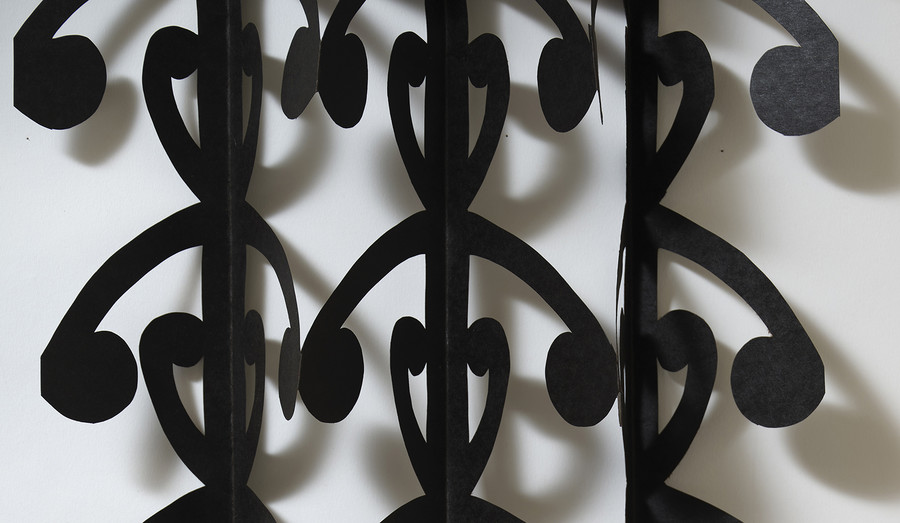
Lonnie Hutchinson Fresh Cut (detail) 2021. Wallpaper, bitumen paper, raffia, pins. Courtesy of the artist
Lonnie Hutchinson’s new exhibition at Te Puna o Waiwhetū Christchurch Art Gallery is a calling—between living rākau rongoā planted on the forecourt of the Gallery and imprints of their leaves cut into wallpaper and metal inside. It questions our construction of spaces, the exterior versus the interior presentation of ourselves, inevitably exposing our own health and that of our taiao. Lonnie talks about rongoā, medicinal plant extracts, as being human-made, in as much as paper is human-made from plants, or aluminium cladding from bauxite in the earth. She carves the shapes of leaves into paper and aluminium and we are asked to step with her into te whare tapa wha—the house of healing. Sir Mason Durie designed this whare with a pillar for our tinana, our hinengaro, our wairua and our whānau and it is these things that I feel Hutchinson is asking us to notice in her deconstructed rongoā built of the elements, extracted from the earth, intrinsic to our whakapapa.
When we talk about this tension of human-made things, it is a fine line, because we as humans like to take credit for a lot of things. Rongoā is really just something we discovered we could utilise, that already exists, because of whakapapa. Our tīpuna were resourceful, making use of the natural elements around them, but they were also considerate, mostly knowing when to protect or cease. As time has gone on, we have become less connected to the resources of nature and our impact and it is this tension I can sense Hutchinson is unpacking in her work.
One of the most beneficial ego busters is the knowledge of your ancestral lines of whakapapa. Knowing who you come after helps to make sense of why we still suck so hungrily from our environment, and ultimately don’t have much to offer back. We are the pōtiki, the youngest of creation. When Papatūānuku was clothed with the forest, the trees in turn oxygenated the atmosphere. Then Hineahuone, the first woman, was formed from clay by Tāne Mahuta. Her breath was the first to draw in that new element, the first to exhale her koha back. Her lineage went back to the heavens: Rehua, Urutengangana and Puanga are all relatives that present as stars. From her, our bodies were crafted from the elements of earth, water and space. Hydrogen, oxygen, carbon and nitrogen fill every cell. Our whare basically houses the table of elements. It begs the question “Why aren’t we better descendants?”
I was told that the reason the trees can heal us is because they were sent to heal our earth mother Papatūānuku. The intelligence of the trees meant that in turn they responded to their environment, and therefore the creatures that began to inhabit the world. A tree can stop a person haemorrhaging, can numb the pain of their nervous system, can stimulate hydrochloric acid production and reduce spasms in the lungs. Trees are the tīpuna, ancestors to ngā tangata. They know things.
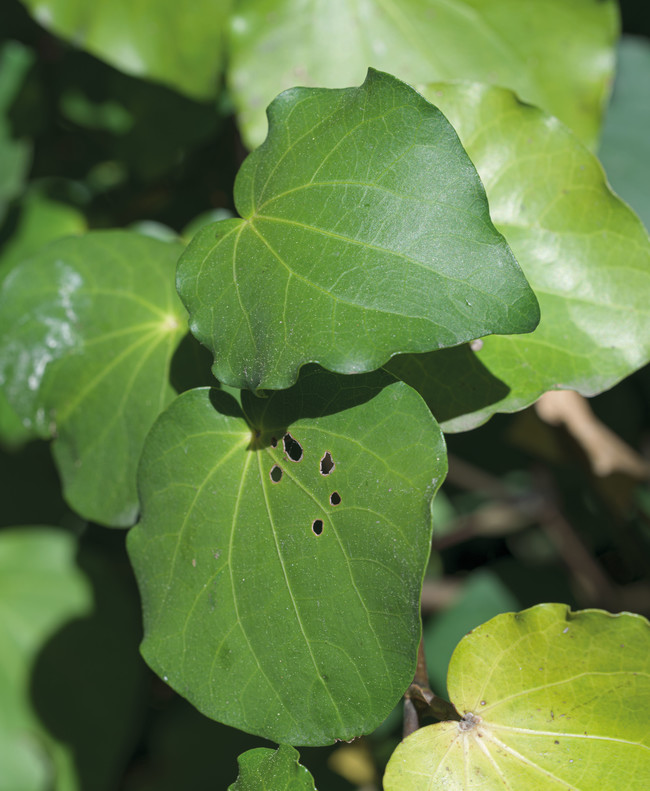
Kawakawa (Piper excelsum). Photo: John Collie

Harakeke (Phormium tenax). Photo: John Collie
Kawakawa (Piper excelsum) was said to have been sent from Io, the highest consciousness, to heal Papatūānuku’s broken heart. Its heart-shaped leaves, despite being ravaged by anuhe, become stronger in our bodies. They fortify our hearts, stimulating our blood flow and our immunity, soothing our puku and calming our minds. Lonnie uses the shapes of kawakawa to leave heart-sized chasms in the fabric of our buildings. Asking for the hearts of people to fill the whare and meet their negative forms, to replenish the symmetry in the hearth.
When I go home to my marae at Waihao, my heart thuds nervously like it is waiting for a shape cut in the walls of the whare to nestle back into. It thuds its doubts loudly: I wasn’t raised here, do I belong? I wasn’t raised here, will you remember me? I wasn’t raised here but I have my Nan’s nose. There on the deforested east coast of the South Island of Aotearoa, rongoā has been carefully planted at the gate of the marae. Tōtara, horopito, mānuka, koromiko and harakeke. The latter’s big silvery tails whip in the wind, the dark kōrari glint from their belly. The gel I collect from the leaves is the most anti-inflammatory, soothing and toning ingredient I know. It quells the cries from grazes and stings, burns and lacerations; it is also the material we use to plait muka ties for our babies’ pito, to weave whāriki for whanau to sit on, kono for our kai to be served in. Sitting to weave makes us slow down—no wonder it is mostly the role of the tāua because all of us have ants in our pants, as my Nan used to say. Not that Nan ever taught me to weave, or even talked of home. She just pinched my nose a bit and sighed, saying I had “gone and got her nose, poor thing”. I wished I was brave enough to tell her that I liked my nose and wanted her to take me home. The gel of harakeke, the ropes and mats and kete, they are binding us across time, pulling us home. They tie our pito, while returning our whenua to the earth, reminding us where we are from. The silver leaves dry golden and warm. They form places to hold things, places to store our hearts.
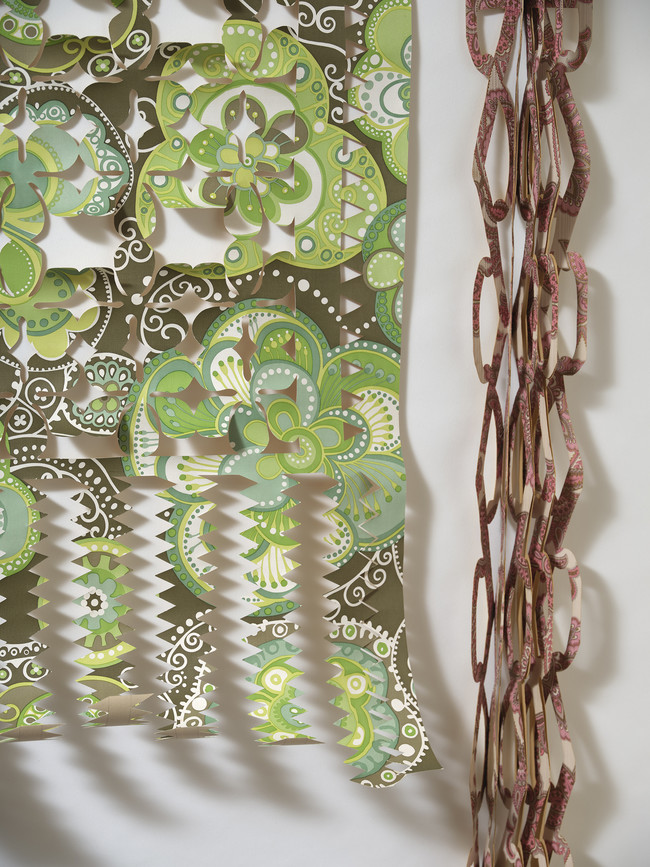
Lonnie Hutchinson Fresh Cut (detail) 2021. Wallpaper, bitumen paper, raffia, pins. Courtesy of the artist
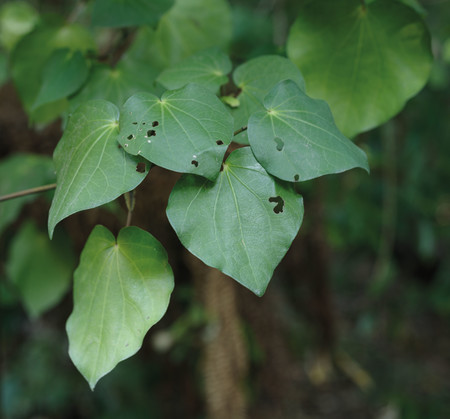
Kawakawa (Piper excelsum). Photo: John Collie
The grass by the marae is dried to a gold rust at this time of year. Like a cursory dusting of rouge over Nan’s parched cheeks. Below the sandy soil, the huge jawbones of a humpback whale are buried to cure and harden in the elements of the earth. When ready they will form the waharoa to stand beside the stone carving of Paikea that greets us as we arrive home. Reminding us that we come through Kahungunu and Porou and are of Paikea. Whakapapa is important.
Bones are made of calcium, and we need vitamin D to absorb that calcium into our skeleton. We need the sunshine to strengthen our bones. When the sunshine catches on the metal of Hutchinson’s work it casts shadows of leaves onto the building. The metal forms push rongoā into the bones of the house and whisper stories of whakapapa from the jaws of their skeleton. No gallery or whare wall will be the same once the stories of these negative spaces have been cast with light. Hine-Tītama, the dawn, was the daughter of Hineahuone, and became the night in the form of Hine-nui-te-pō. We come from her in life and we go to her in death. So before the first light of dawn breathes on the human-made creations of our natural world, we bless their passing from te ao, the light, to te pō, the darkness. When a new whare is blessed, because the materials came from ngā atua, such as wood and paper from Tāne or metal from Papa, the tapu is lifted with karakia. Kawakawa leaves are used to communicate between the two spaces of tapu, sacred and noa, neutral, as they are a gift from Io, the Supreme Being, to Papatūānuku, Earth Mother. The shapes of our hearts are the leaves, the gateway they create is to traverse to te taha wairua, clearing the path.
When the tapu is lifted from Lonnie Hutchinson’s new works at the Gallery, the marama will be in Ōkoro, the first quarter of the moon. It is a good time for planting all the way to Tamatea-āio, the perfect balance of a half moon. When the light of Ōturu the full moon is here, the shapes of plants will be etched into the walls of the building with the karakia of the atua they whakapapa to. The mauri of the line of ancestors, the atua and the stars will be reflected in the strength of the moon’s glow and our harvest.
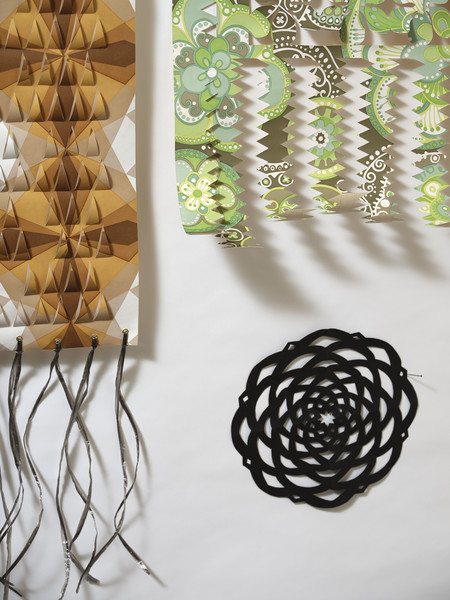
Lonnie Hutchinson Fresh Cut (detail) 2021. Wallpaper, bitumen paper, raffia, pins. Courtesy of the artist
What each of us harvest from the imprints Hutchinson creates will be different. What detail we notice, what sounds we hear alongside the visual imagery will be only ours. The aligning marama above us will cast a different horoscope on our experience and the line of whakapapa behind us will determine what stories come through to remind us to go home. The muka fibres of harakeke will whip around our waists reminding us that we are soothed and bound in a long line of birth and death. The wind of Tāwhirimatea will blow the leaves that made the ropes and the soil will start to soften into something more inhabitable. The whāriki will be laid down inside the whare beside the table of elements and we will be invited to come inside and breathe oxygen and release carbon and remember our hinengaro is just as, and no more, important than our wairua. The tāua will sit weaving and remind us we are always rushing and that keeping quiet wouldn’t hurt. The jawbones of whales take years to cure in the cool earth of Papatūānuku. Bones that needed the sunlight, now need the darkness. The cycle of birth and death to remind us that we came from whales and there is no rush—and this is perhaps the real rongoā. Taking time to slow down and listen to the sounds that come with the images cast in shadows, weaving the connections that were always there; the ones we are too busy to listen to most days. The trees just planted out front may outlive us all and they know things. Like how to heal our broken hearts and trace broken lines home. Trees that have been sitting for hundreds of years, slowly absorbing our carbon and releasing oxygen for us to breathe and falling to become waka and wharenui. They’ve grown from the nutrients of bones in the soil that once needed sunlight. They’ve grown in miniscule incremental millimetres and bloomed and fruited and scattered seed. A tree can stop a person haemorrhaging, can numb the pain of their nervous system, can stimulate hydrochloric acid production and reduce spasms in the lungs. Trees are the tīpuna to ngā tangata. They know things. We are their descendants and so no wonder we feel like they did all the hard work. One day though, we’ll have to be good tīpuna too. We’ll need to find the place our shadow is cast, the place our heart is cut out for, a place where we could scatter seed.
Glossary
anuhe-kūmara moth caterpillars
atua-deity, ancestor with continuing influence
hinengaro-intellect, mind, consciousness
karakia-incantation, prayer
koha-gift
kono-small basket
kōrari-flower stem of harakeke (flax)
marama-moon
mauri-life force
muka-prepared central fibres of harakeke (flax)
ngā tangata-all people
noa-neutral
Papatūānuku-the land
pito-bellybutton
pōtiki-youngest child
Puanga-Rigel, seventh brightest star in the night sky, recognised by some Iwi in the far north as the harbinger of Matariki, the Māori New Year
puku-stomach, instinct
Rehua-Antares, the brightest star in the constellation Scorpius and associated with summer
rongoā-medicinal plant extract
tapu-sacred, restiricted, or reserved
tāua-grandmother (Ngāi Tahu dialect)








